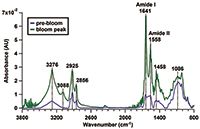ATR–FT-IR Investigation of the Ocean Surface
Application Notebook
The impact of ocean microbiological activity on the chemical species present in the sea surface microlayer (SSML) was investigated using attenuated total reflection-Fourier transform infrared (ATR–FT-IR) spectroscopy. We observe clear chemical differences in organic functionality before and during the peak of an induced phytoplankton bloom.
The oceans cover 71% of Earth's surface. Therefore the SSML, at the air-sea interface, strongly influences the transfer of material between the ocean and atmosphere via sea spray production (1). Understanding the dynamic changes in SSML chemistry due to microbiological activity is a critical step to unraveling the link between ocean chemistry and climate. Here we used ATR–FT-IR to identify changes in the organic species present in the SSML as microbiological activity alters seawater chemistry.
Experimental Conditions
SSML samples were collected daily using the glass plate method (1) during a large-scale mesocosm experiment (2) and stored at -80 °C until analysis. After thawing, organics were isolated via solid phase extraction (Bond Elut PPL, Agilent Technologies) into methanol (3), deposited onto a 80 × 10 × 2 mm ZnSe multiple reflection ATR trough plate of the PIKE Technologies HATR accessory (Madison, WI) and dried under nitrogen for 24 h. Spectra were acquired at 4 cm-1 resolution (200 scans) after 30 min of instrument purging with nitrogen.
Results
The sensitivity of the ATR measurements was enhanced by using a multiple reflection ATR plate with 20 reflections contacting the sample, and 40 total reflections. Absorbance values were amplified roughly by a factor of 20 relative to expected results from a single reflection ATR.
ATR–FT-IR SSML spectra obtained before and at the bloom peak are shown in Figure 1. The pre-bloom spectrum contains peaks in the C-H, O-H and N-H stretching regions near 2900 and 3300 cm-1, respectively. These peaks suggest the presence of aliphatic C-H groups due to fatty acids and lipids as well as the presence of alcohols, sugars, and amino acids.

A peak in phytoplankton concentrations corresponds to an increase in organic functional group signal intensities. In addition, several peaks are more prominent and new peaks appear. Specifically, sharp peaks at 1641 and 1558 cm-1 are associated with the amide I and amide II bands, respectively, of proteins in the SSML (4). Also present at higher frequency that becomes more apparent in the spectrum is a band at 3088 cm-1 which is most likely associated with the overtone of the amide II band (5).
The amide I and II bands are particularly noteworthy and suggest that proteins, likely from microbial cell fragments, are abundant in the SSML during periods of high biological activity. Biological particles are known to have profound impacts on cloud properties and precipitation (6). Therefore SSML enrichment of proteins and cell fragments may lead to enhanced transfer to the atmosphere via sea spray and play a crucial role in affecting marine clouds and climate.
Conclusion
Using a highly sensitive multiple reflection ATR accessory, we identified changes in SSML chemistry resulting from microbiological activity. Results suggest that proteins are abundant in the SSML during a phytoplankton bloom. This enrichment likely alters sea spray chemistry, which has subsequent implications for atmospheric chemistry, clouds and climate.
References
(1) M. Cunliffe, A. Engel, S. Frka, B. GašparoviÄ, C. Guitart, J.C. Murrell, M. Salter, C. Stolle, R. Upstill-Goddard, and O. Wurl, Prog. Oceanogr. 109, 104–116 (2013).
(2) X. Wang, C.M. Sultana, J. Trueblood, T.C.J. Hill, F. Malfatti, C. Lee, O. Laskina, K.A. Moore, C.M. Beall, C.S. McCluskey, G.C. Cornwell, Y. Zhou, J.L. Cox, M.A. Pendergraft, M.V. Santander, T.H. Bertram, C.D. Cappa, F. Azam, P.J. Demott, V.H. Grassian, and K.A. Prather, ACS Cent. Sci. 1, 124–131, (2015).
(3) T. Dittmar, B. Koch, N. Hertkorn, and G. Kattner, Limnol. Oceonogr.: Methods 6, 230–35 (2008).
(4) P. Roach, D. Farrar, and C.C. Perry, J. Am. Chem. Soc. 127, 8168–8173 (2005).
(5) S. Suzuki, Y. Iwashita, and T. Shimanouchi, Biopolymers. 4, 337–350 (1966).
(6) J. Sun and P.A. Ariya, Atmos. Environ. 40, 795–820 (2006).

PIKE Technologies, Inc.
6125 Cottonwood Drive, Madison, WI 53719
tel. (608) 274-2721
Website: www.piketech.com
